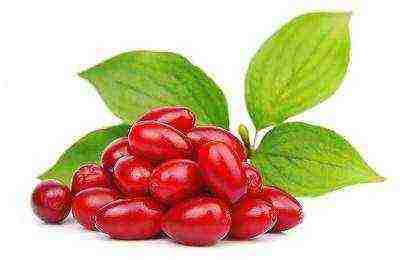Content
- 1 The best remontant varieties of raspberries
- 2 The best classic raspberries
- 3 The best standard raspberry varieties
- 4 The most popular raspberry varieties
- 5 Raspberry remontant. The best varieties
- 6 1. Hercules
- 7 2. Patricia
- 8 3. Bryansk miracle
- 9 4. Bristol Black
- 10 5. Eurasia
- 11 6. Crane
- 12 7. Senator
- 13 8. Fantasy
- 14 9. Scheherazade
- 15 10. Maria
- 16 11. Golden Autumn
- 17 12. Golden domes
- 18 13. Orange miracle
- 19 14. Cleopatra
- 20 Patricia gives 8 kg per bush
- 21 Glen Magna for the southern regions
Review of the best varieties of the sweetest raspberries according to gardeners' reviews
Raspberries are a popular and healthy summer berry. Old adapted varieties in Central Russia are distinguished by their unpretentiousness and vitality. On the site, raspberries can even behave aggressively, capturing new territories and expanding the boundaries of the raspberry. This behavior is due to the characteristics of the varieties and lack of care. The best varieties of raspberries according to reviews of gardeners from different regions are presented in our rating.
Raspberry varieties are conventionally divided into 4 groups: large-fruited, classic, renovation and standard (tree-like).
Large-fruited raspberry inherited from the parental forms a high mass of berries and low winter hardiness. When growing large-fruited varieties of raspberries in the Middle Lane, the shoots are bent down and covered for the winter. To obtain large berries, you will need to create the appropriate conditions: the introduction of organic matter, top dressing, prevention of diseases and pests, regular watering. On poor soils, you cannot get a good harvest, and in a drought the berries will simply dry out on the branches. The brightest representative of the group, which has many fans and is grown even in the Urals - Krasa Rossii.
Stock raspberrydespite the growing interest in the group, it remains exotic in Russian gardens. These varieties of raspberries are decorative, easy to pick berries, disease resistance and high yield (due to active lateral branching). "Raspberry tree" does not need support, the crown retains its shape under the weight of the berries. At the same time, the varieties show good frost resistance and unpretentious care. Formation consists in pinching the tops of the shoots by 10 - 15 cm. In this group, the Tarusa variety is distinguished.
Classic raspberry varieties bear fruit on the shoots of last year, so the ripening of the berries begins early: from the end of June to July. Bushes winter with long shoots, which are recommended to be covered in the conditions of the Moscow region.
Repair raspberry bears fruit on both last year's and young shoots. But experienced gardeners recommend cutting out all the shoots in the winter and getting one late harvest on a young growth. In this case, the yield will be higher and the size of the berries will be larger. Fruiting period for remontant varieties: from late July to September-October. Many varieties of remontant raspberries are well suited for the Moscow region. Their advantages: they winter without problems, do not suffer from pests, and are superior in yield.
The choice of the best raspberry variety also depends on the purpose of the raspberry planting: for home use of dessert berries or for the sale of a marketable crop. Commercial varieties are distinguished by high yields, transportability and attractiveness of berries, but inferior in taste.
The best raspberry varieties according to gardeners' reviews
The best remontant varieties of raspberries
|
Polka 250 (for one year old seedling in a bag with wet moss) A remontant dessert variety of Polish selection. Sprawling bush, 1.6 - 1.8 m high, forms little root growth, gives up to 10 replacement shoots. Shoots are strong, do not bend during fruiting, covered with small, thornless thorns. The berries are dark red, rounded-oblong, with an average weight of 5-6 g, sweet taste, with a pronounced bright aroma, well stored and transported.The yield of one bush, with proper care, exceeds 4 kg. Berries do not crumble, are transported, due to dry separation, they are ideal in freezing. Shows high resistance to gray rot and spider mites, but susceptible to cancer of the measles system. It has low winter hardiness, but with complete mowing of shoots, this disadvantage is not of paramount importance. In arid climates, it behaves badly. This remontant variety of raspberries received good reviews from gardeners in the Rostov region and the Moscow region. Main pluses:
Minuses:
|
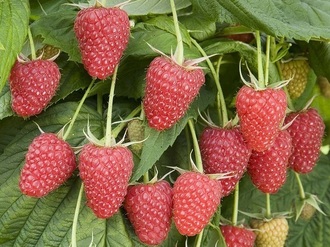 9.8 / 10 Rating Reviews The most delicious remontant berry. In regions with harsh winters, it is best to cut flush with the ground and mulch well.
|
|
Bryansk miracle 270 (for one year old seedling in a bag with wet moss) Repaired raspberry variety for commercial purposes and personal use. It is late in terms of ripening. The bush is 1.5 - 1.9 m high, slightly spreading, the formation of overgrowth is medium. The main shoots are thick with sparse soft thorns; there are no thorns on the fruit branches. The garter is done only in windy areas. Also, due to the long side shoots, the garter contributes to better ventilation and illumination of the lower tier. Berries of classic red color, cylindrical, elongated, up to 3 - 4 cm long, weighing from 5 - 7 to 11 - 20 g. Average yield - 3 kg per bush. The taste is sweet with sourness. The palatability rating is good and excellent. The berries are dense, store well and tolerate transportation. In order for the bush to realize its potential yield, the lower buds are removed, accelerating the ripening of the upper ones and promoting the formation of larger berries. It prefers light fertile soils; on heavy loams, the yield decreases sharply. Average winter hardiness. In winter, it is recommended to mow the shoots to the ground, since the stump left takes away strength from the rhizome and reduces winter hardiness. The variety does not perform well in arid regions. Recommended for the Moscow region and the Central strip. Main pluses:
Minuses:
|
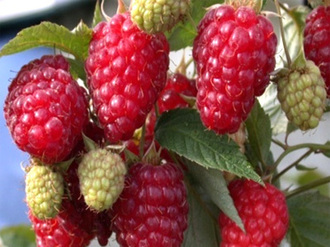 9.7 / 10 Rating Reviews This variety of raspberries fell in love with the late ripening, when only apples were left in the garden. With good care and proper fit, there are no problems with it.
|
|
Orange miracle 250 (for one year old seedling in a bag with wet moss) Repaired variety with orange berries. The bush is medium-sized, up to 1.7 m high, compact. Shoots are erect, heavily spiked, fragile and can break off under the weight of the berries. The formation of fruit branches is active and covers 2/3 of the length of the shoot. The bush forms up to 7 replacement shoots and gives a lot of growth. The berries are cone-shaped, with a slightly pointed apex, dense, even, up to 4 cm long and weighing 6 - 12 g. They have a delicate aroma and sweet taste with a slight sourness. The sugar content depends on the soil and climatic conditions of cultivation and the level of agricultural technology. The berries are well transported; when overripe, they remain on the branches. The yield from one bush reaches 3 kg, while before frost the variety manages to give 70 - 100% of the potential yield. There is a high resistance to pests and an average - to diseases. Dessert berry taste and good transportability make the variety versatile. The variety has shown itself well in the Moscow and Rostov regions, it is recommended for the Central strip, the Urals and Western Siberia. When grown in an annual culture (cutting on a stump in winter), there is no risk of freezing of the shoots. Main pluses:
Minuses:
|
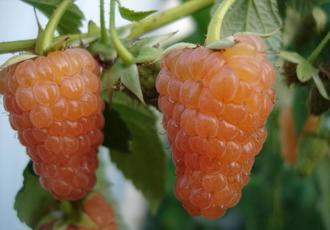 9.7 / 10 Rating Reviews The best sort of remontant raspberry for the Moscow region, in my opinion. The berry is tasty and very beautiful, ripens quickly.If you cut off the unripe berries along with the stalk, then they ripen perfectly.
|
|
Hercules 450 (for a 2 year old seedling in a container) Repaired commercial grade. The bush is 1.6 - 1.8 m high. The shoots are erect, with rigid thorns along the entire length, strong and do not require support. Lateral branching is abundant, shoots are weak (up to 3 - 4 replacement shoots). The variety tolerates thickened plantings well, does not require frequent thinning. Ruby berries, in the shape of a truncated cone, dense, weighing from 6 - 10 to 15 g, with a pronounced aroma. The taste is sweet and sour, refreshing, but in cold weather the sourness is more pronounced. The yield from one bush reaches 4 kg. Differs in high resistance to diseases (including viral) and pests, drought-resistant and winter-hardy. Waterlogging spoils the taste of the berry, making it watery. With a lack of heat and lighting during the ripening period, the berries turn out to be sour, they are good in compotes and jam. This variety of raspberries has adapted well in the Moscow region, the Middle Belt and the Urals, showing stability and unpretentiousness. In regions with cold rains in the second half of summer, it is impossible to get a high-quality berry without additional measures. Main pluses:
Minuses:
|
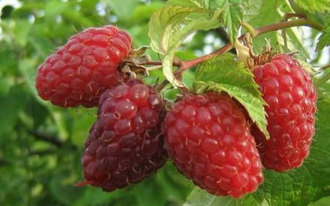 9.5 / 10 Rating Reviews For beginners, this raspberry is the easiest to care for in comparison with other remontant varieties, top dressing and a well-chosen site, it is possible to get delicious berries.
|
|
Firebird 220 (for one year old seedling in a bag with wet moss) Repaired grade for small areas. Gardeners appreciate it for its excellent taste. In terms of yield, transportability and size it loses to other commercial varieties. More often grown for personal use. The bushes are compact, up to 2 m high, forming 5 - 8 replacement shoots. Shoots are covered with soft and thin thorns, to a lesser extent on the upper part. A garter to the trellis is required. Bright red berries of a conical shape with a blunt top, glossy, drupes are large, dense, weighing 4 - 6 g. The yield per bush is 2 - 2.5 kg. Ripe berry does not crumble. If the berries are picked regularly, avoiding overripening, then the harvest is well transported. This raspberry shows good results in the southern regions, but due to insufficient heat resistance it needs mulching and shading. In the northern regions, it manages to realize only 70% of the potential yield. Main pluses:
Minuses:
|
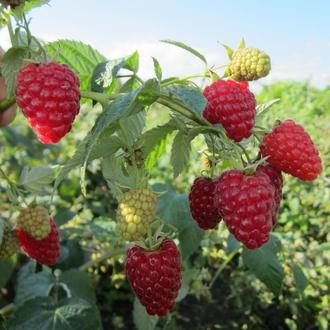 9.5 / 10 Rating Reviews An excellent dessert berry, it does not prick strongly, so the collection of berries is without negative. The care is the same as for other remontant raspberries.
|
The best classic raspberries
|
Kuzmin's news 250 (for one year old seedling in a bag with wet moss) An old classic mid-season raspberry variety that does not lose its popularity. Grown for fresh consumption and processing, not suitable for commercial purposes. Bushes are tall, from 2 to 2.5 m, erect, slightly spreading, they form few root suckers. Gives few replacement shoots. Shoots are arched, drooping. Thorns are long and thin (shorter and thicker towards the apex), cover all shoots, but their number is average. The berries are oblong, dyed red, with an average weight of 2 - 5 g, with a weak aroma. The taste is excellent, but the berries are not suitable for transportation and storage. When ripe, they are easily separated from the stalk, but do not crumble when overripe. On average, 1.5 - 2 kg can be harvested from one bush. In favorable years, repeated fruiting is possible on young shoots. The variety is not picky about soil types and care, but has a low drought tolerance.In the absence of watering, the beginning of fruiting is delayed by 2 - 3 weeks. Poorly tolerates drafts and is susceptible to viral diseases. In general, the variety is characterized as the most hardy and is recommended for "lazy" and inexperienced gardeners. It is grown in all regions of Russia, but is of particular value for the Central belt, the Urals and Western Siberia. Main pluses:
Minuses:
|
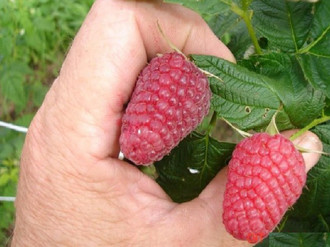 9.5 / 10 Rating Reviews The best raspberry variety for Siberia, for fresh consumption. I have 2 bushes planted especially for children. The overgrowth does not torment, I also don’t fiddle with shelter.
|
|
Yellow giant 300 (for one year old seedling in a bag with wet moss) A classic variety of early ripening yellow raspberries. The bush is powerful, 2 - 2.3 m high. 8 - 10 replacement shoots are formed, but the bush remains compact and does not fall apart. Young shoots without thorns, on old ones - in small numbers. It is prone to strong branching of fruit branches: up to 4 - 5 orders of magnitude. Intensive development of root growth. The main fruiting is on last year's shoots, but under favorable conditions, a second wave of fruiting is possible at the tops of the young growth. Amber-yellow years broadly conical with a blunt apex, up to 4 cm long and weighing 8 - 10 g. The yield per bush exceeds 4 kg. Due to poor transportability, they are used only for personal use. In the middle lane, it shows insufficient winter hardiness and requires additional protection. Shoots are flexible and bend easily for winter shelter. Main pluses:
Minuses:
|
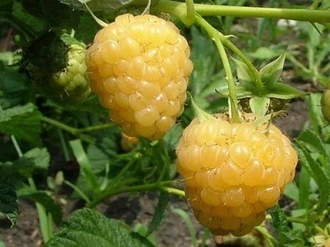 9.5 / 10 Rating Reviews I keep several bushes of this raspberry as a treat. The variety is appreciated for its excellent taste and beautiful berry. Not suitable for sale, processing and freezing.
|
|
Patricia 200 (for one year old seedling in a bag with wet moss) A classic variety of large-fruited raspberries. Sprawling bush, 1.5 - 1.8 m high, annually gives 6 - 10 replacement shoots. Forms a lot of root growth, which should be removed in a timely manner. A garter to the trellis is required. Shoots of the first year without thorns. At the end of the season, formative pruning of the shoots is required. Fruiting begins in mid-June and lasts until mid-August. The berries are bright red, cylindrical or irregular in shape, with a velvety bloom, with an average weight of 5 - 6 g (up to 10 - 12 g). Drupes are large, fit tightly. The aroma is pronounced. The average yield is 4 - 5 kg per bush, but it can reach 8 kg. The berries do not tolerate transportation well and are not intended for long-term storage. The variety does not tolerate waterlogging. Recommended for the Central region of Russia, but successfully grown in the Urals. Main pluses:
Minuses:
|
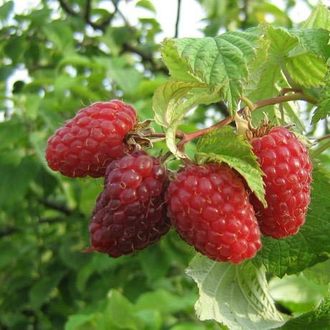 9.4 / 10 Rating Reviews Berries with a very delicate pulp, ideally: pick and eat immediately. With the harvest, raspberries cannot be postponed - overripe berries mold and crumble.
|
The best standard raspberry varieties
|
Tarusa 300 (for one year old seedling in a bag with wet moss) Standard raspberry with late ripening. In one season, a branchy tree grows up to 1.8 m high, with thick shoots on a trunk. Shoots are elastic and do not need a garter, there are no thorns. The variety branches beautifully and does not need special labor-intensive pruning. Gives 3 - 4 replacement shoots annually. No more than 10 shoots are left in the bush. Berries are burgundy-red, sweet and sour, conical or irregular, up to 10 - 15 g, dense and transportable, have a pronounced aroma and are good for processing. Small seeds are almost not felt. Productivity is high: up to 4 kg per bush. Despite the high declared winter hardiness, freezing is observed in the windy area in snowless winters. Grown from the Moscow region to the Urals. In rainy summers, the berries are watery and sour. The taste is strongly influenced by grooming and feeding. Main pluses:
Minuses:
|
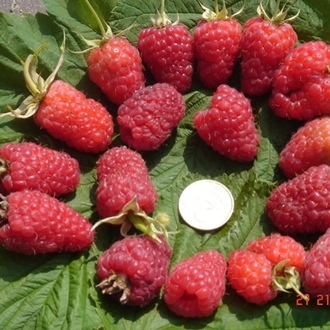 9.7 / 10 Rating Reviews The shoots at Tarusa are powerful, but under the weight of the crop they still sag and can break, so I use a trellis. Good yield, we use it for making jam and jam - it turns out very fragrant.
|
|
Monomakh's hat 270 (for a one year old seedling with a bag of wet moss) Standard raspberry variety with remontant fruiting. The bush is up to 1.5 m high, forms up to 5 powerful branched shoots with drooping tops. The lower part of the shoots has hard thorns. Due to the weak formation of shoots, cuttings are more often used for reproduction. Berries of juicy red color, weighing from 7 to 20 g, pyramidal with a blunt top, sweet with a slight sourness and bright aroma, leveled and mouth-watering. When assembled, they do not fall apart, are suitable for storage and transportation. An average of 4 - 5 kg is harvested from one bush. Reacts painfully to interruptions in watering, tying small berries. The variety has an average winter hardiness. In the northern regions, under conditions of early frosts due to late ripening and extended fruiting, it realizes only 50% of the potential yield. This raspberry variety is good for the southern regions. In the middle lane, it is grown in an annual crop, when in autumn the shoots are cut to ground level. Main pluses:
Minuses:
|
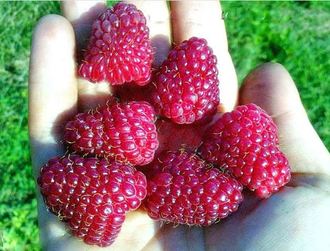 9.3 / 10 Rating Reviews Dessert-tasting berries, neat, fruitful bushes. Raspberries require attention, but this is for all large-fruited varieties.
|
Studying the varietal diversity in the catalogs of online stores or nurseries, one should not forget about acclimatization and varietal testing in new climatic conditions for the variety. If the raspberry variety seems attractive to you and has positive reviews in other regions, then first you should buy 1 - 2 bushes, provide them with better conditions and conduct your own assessment. The taste, the strength of growth, the ripening period are largely determined by the growing conditions: the climatic zone and agricultural technology.
Have a nice harvest!
Attention! The reliability of the information and the results of the ratings is subjective and does not constitute advertising.
When growing raspberries, each summer resident takes into account many factors that affect productivity. But in order to obtain a high yield, in addition to providing optimal conditions for active growth, it is necessary to select the best varieties of raspberries. It is advisable to choose planting material in accordance with climatic and regional conditions, and it is also necessary to carefully study the properties of each selected variety.
Today, in specialized stores, in spontaneous markets, in gardening enterprises, you can see a large number of seedlings. But you should pay attention to the fact that the varieties are divided into categories of cold resistance. More thermophilic raspberries will not yield crops in colder regions, even under greenhouse conditions. What popular varieties of raspberries are recommended by summer residents and gardeners for growing in a particular region?
The most popular raspberry varieties
The hearts of most gardeners and gardeners are conquered by medium varieties.They are considered versatile and can produce an average yield and bear fruit under moderate conditions, withstanding even slight cold. As summer residents note, such a raspberry fully satisfies human needs. Popular varieties of this garden plant:
- Canadian. Very sweet raspberry. Differs in a complete absence of acidity. Her berries are small, but very tasty. Each of them weighs about 9 grams. The plant itself is tall, and can reach up to 2 m in height. For one season, it can give about 7-9 kg. ripe fruits. Raspberries of the Canadian variety love moisture, but among the properties is its resistance to obedient climatic conditions. Doesn't require any special care - everything is according to the standard.
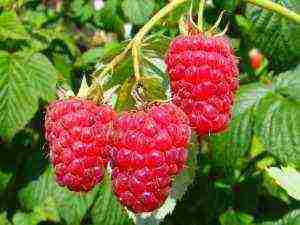
- Aboriginal. You can safely classify the best early raspberry varieties. The berry was bred by Russian breeders and is recommended for growing in moderate conditions. It does not tolerate cold well, but at the same time it can independently recover in a year by means of new shoots. The fruits of the Aboriginal variety are not large and weigh about 5 g. Large berries can weigh up to 8-9 g. The bush is defined as medium in height and does not exceed one and a half meters in height. For the season, it can give up to 6 kg. A remarkable property of the variety is that it is practically not affected by pests and diseases.
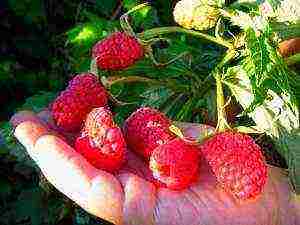
- Faith. Another sweet raspberry variety. The best varieties in terms of taste are the category to which these berries belong. Productivity from one bush is not less than 4.5 kg. The bush grows no more than 1.5 m and gives small berries up to 4 grams. Loves moisture very much, so it should be watered thoroughly. Among the main properties is also conditional resistance to heat and extreme cold.
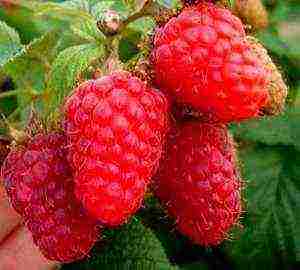
- Meteor. The earliest variety of raspberries among the versatile. The berries ripen in early July almost simultaneously (up to 3 grams. Each. They have a pronounced cone-shaped ruby color. The bush is powerful, low up to 1.2 m. It has resistance to diseases and, relative to other varieties of raspberries, Meteor is frost-resistant. Productivity - 2 kg / bush The taste and aroma will always delight the summer resident. All this is quite enough to open the raspberry season.
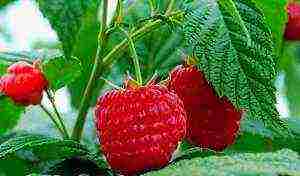
- Alyonushka. If at the stage of selecting varieties for a summer residence there is a question about which varieties of raspberries are better to choose, many advise Alenushka. This is one of the most productive varieties. Up to 13 kg / season are harvested from this plant. As for the taste, there is a slight sourness in them. At the stage of ripeness, this is not noticed, but in the process of making jam, you need to add extra pounds of sugar. But this cannot be considered a disadvantage. Alyonushka raspberry bush can reach up to 2.5 m in height. The growing process of this raspberry requires a garter to the trellis or supports. It should be noted that the variety is resistant to many unfavorable conditions, including frosts, it does not have any problems.
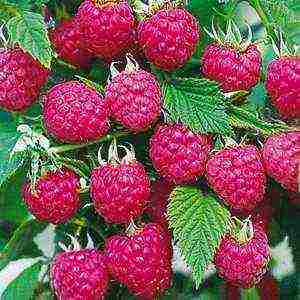
In addition to the above varieties of raspberries, there are also two varieties that I would like to note: Marlboro and Taganka. In terms of properties and productivity, the Marlboro raspberry is not inferior to the Alenushka variety, and the Taganka raspberry is the best late variety. It can withstand frosts down to -20C and more.
Raspberry remontant. The best varieties
What is a remontant raspberry? It differs in that the crop can be harvested from the first year of planting seedlings in the soil. This advantage is especially important for those who are engaged in the cultivation of raspberries in order to improve their financial situation (as a business). Getting a quick result in a short time is the main goal of summer residents-entrepreneurs. For summer residents who grow berries for themselves, this advantage is also important, but the amateur summer cottage business requires thoroughness and time.
What are the best varieties of remontant raspberries that exist today:
- Shugan. It has excellent taste and large fruits. On average, up to 10 kg are harvested from one bush. harvest for the season.It is considered a high-yielding Swiss variety. The plant has a strong stem that reaches 1.6 m in height. With this growth, he does not require a garter. Among the remarkable properties, it should be noted the long-term preservation of the presentation (they do not crumple up to 4 days).
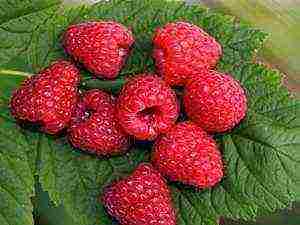
- Polka. Polish breeders also presented their raspberries. The best variety is Polka. Popular in our country. For Europeans, this is also one of the best varieties. As for the plant itself, it grows up to 1.5 m and has strong stems. The berries of this raspberry variety are quite large and have an impressive weight. At the same time, a good average yield is harvested from one bush. The peculiarity of the variety is that it can produce up to 100 shoots per 1 m2 area. This allows it to multiply quickly. The berries have a very sweet taste, the Polka raspberry variety belongs to the dessert category.
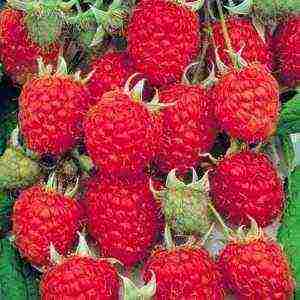
- Bryansk miracle. One of the earliest varieties. The fruits have an elongated, conical shape and excellent taste and aroma. The first berries can be eaten around the 10th of August. The yield of the variety is good. They retain their freshness and presentation well for 5-6 days. A remarkable property is its resistance to drought and frost. This is one of the best varieties of remontant raspberry for Siberia.
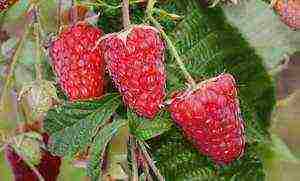
- Hercules. A novelty on the market of fruit and berry crops. This is a mid-season remontant variety with erect, powerful stems. The berries are round, conical and purple in color. The taste is sweet with sourness. An average crop is harvested from the bush. The first berries can be tasted at the beginning of August. Noteworthy is the fact that the stems have large thorns and a slight waxy coating. This is its bright, distinctive feature. This variety is one of the best raspberry varieties for the Moscow region (see photo).
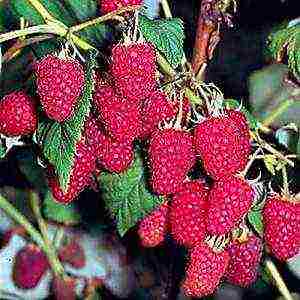
- Indian summer-2. This novelty was presented quite recently, but it has already become known among businessmen and ordinary summer residents. Due to the structure and powerful stems, the bushes of this variety do not require a garter. Most of the fruits can be eaten in the first half of September. The rest of the harvest is harvested before winter. It tolerates changeable climate conditions well, and adapts well to changeable climates.
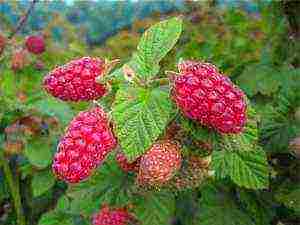
In addition to these varieties of raspberries, there are many others: Eurasia, Monomakh's Hat, Kalashnik, Morning Dew, Apricot.
Raspberry remontant, video
Every gardener dreams of eating juicy and large raspberries. Find out which varieties of large-fruited raspberries you can grow on your own site.
The large-fruited group includes raspberry varieties that produce berries weighing 4-12 grams. Some record-breaking berries can reach a weight of about 20 grams.
As a rule, a large-fruited seedling can be distinguished by the elongated sepals of the flower.
1. Hercules
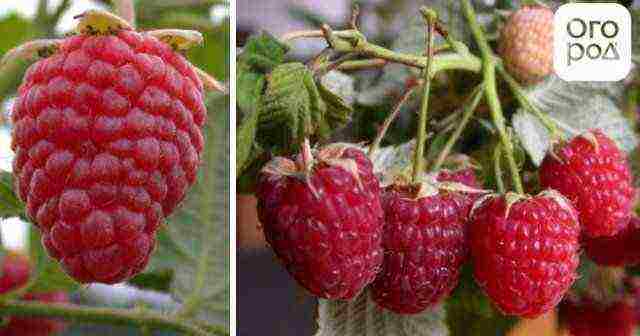
Large-fruited variety of raspberries. The berries have a regular shape, ruby color. They ripen early. In addition, the variety is resistant to most raspberry diseases.
2. Patricia
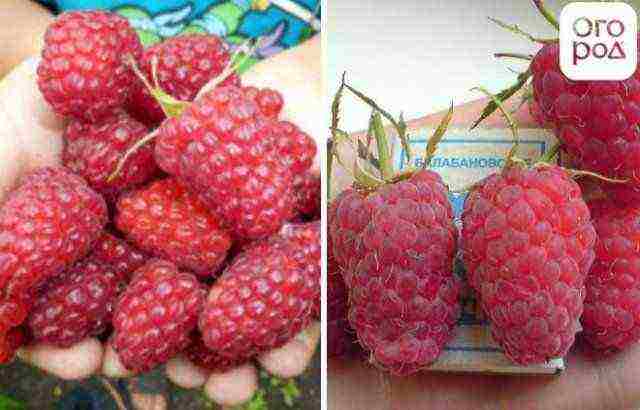
Winter-hardy large-fruited and high-yielding non-repairable variety. The berries are juicy, aromatic, sweet. Plants are medium-sized, semi-spreading bushes. Berries weighing up to 14 g, have a truncated-conical shape, a beautiful velvety surface. Berries of medium density, have a sweet raspberry aroma. Early ripening variety, bears fruit every year.
3. Bryansk miracle
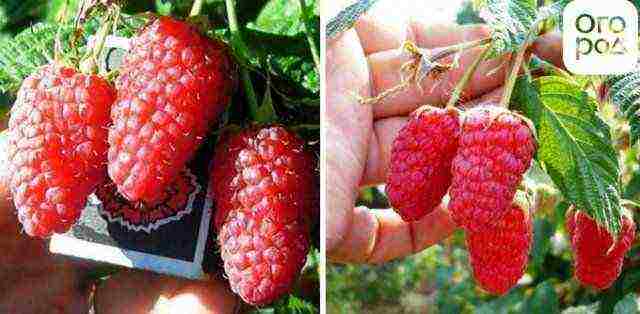
A compact bush, medium-sized, has large elongated-conical berries, the weight of which reaches 6 g. The variety is high-yielding, 4-5 kg per bush.
4. Bristol Black
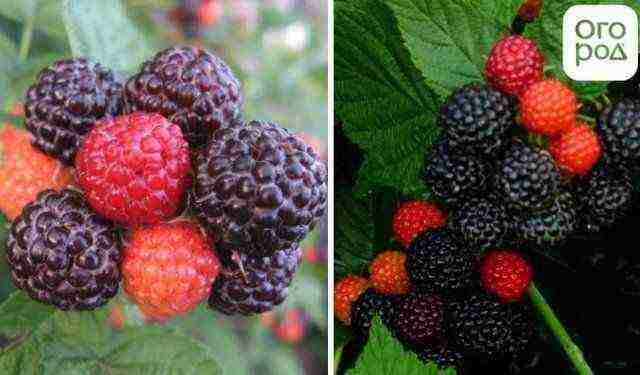
Medium bush. The berries are medium in size, black, round, with a whitish bloom. They have a great taste, ripen at the end of July. The plant is weakly susceptible to diseases and pests.
5. Eurasia
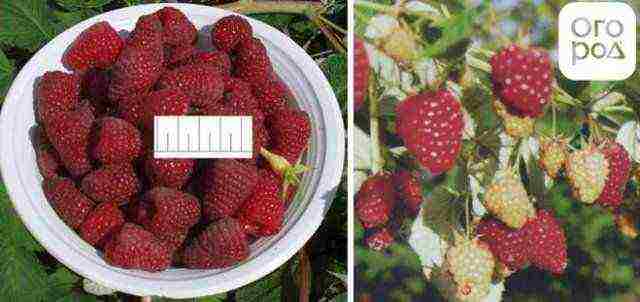
One of the remontant varieties. Has large berries, good yield and high early maturity. Berry yield - 2.0-2.5 kg per bush. Differs in resistance to pests and diseases. The bushes give a high yield in various soil and climatic conditions.
6. Crane
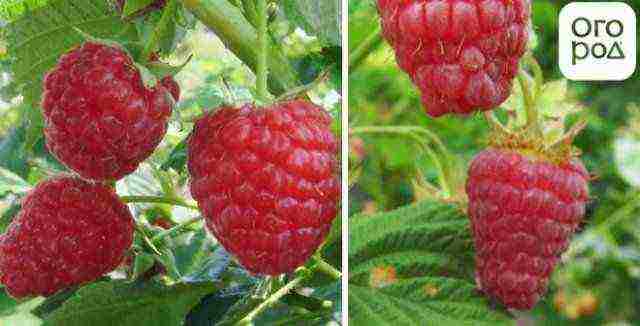
A variety of medium ripening, winter-hardy, yield up to 2 kg. The bush is compact, medium-sized. The shoots are strong. The berries are blunt-conical red, have a slight pubescence, sweet-sour pulp, weight 2.7-3.5 g. The variety is resistant to fungal diseases, raspberry mite.
7. Senator
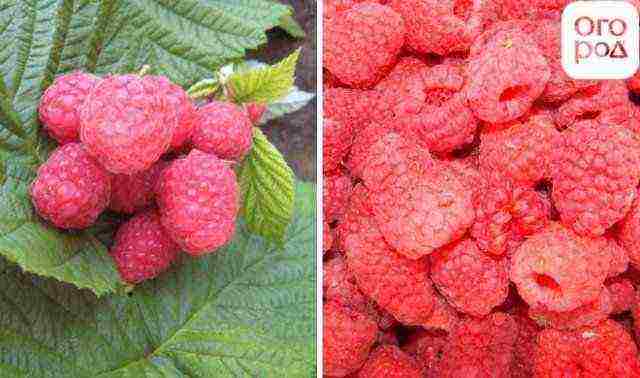
One of the most productive and winter-hardy varieties, which has an average ripening period. Raspberries of this variety yield up to 4.5 kg per bush. The berries are red-orange, conical, very large, up to 7 g, dense. The pulp is juicy, has a sweet and sour taste. The bush is high, the shoots are straight, thornless. The variety is resistant to diseases and pests.
8. Fantasy
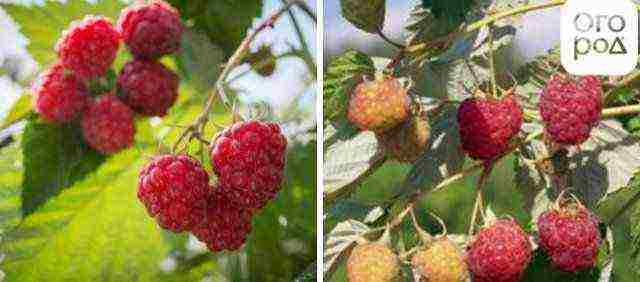
A variety that does not have thorns. The mass of berries often exceeds 7 g. It has a weak winter hardiness.
9. Scheherazade
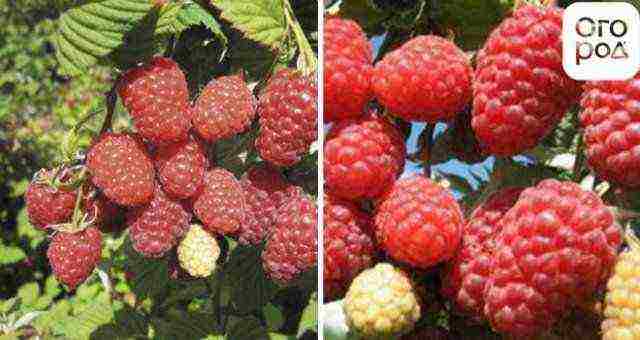
A variety of medium ripening. It is characterized by strong growth and medium spreading of the bush. The berries are large, have a weak aroma, reach a mass of 6 g or more. The yield of the variety is up to 4 kg per bush.
10. Maria
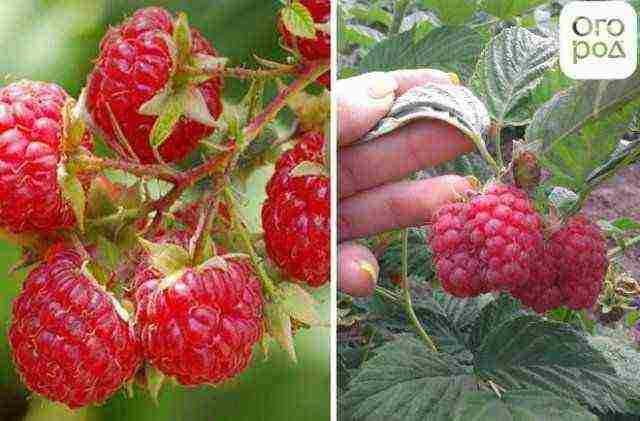
A variety of medium ripening. The berries are large and sweet, weighing up to 4g. They have a deep red color, elongated shape, suitable for processing and fresh consumption.
11. Golden Autumn
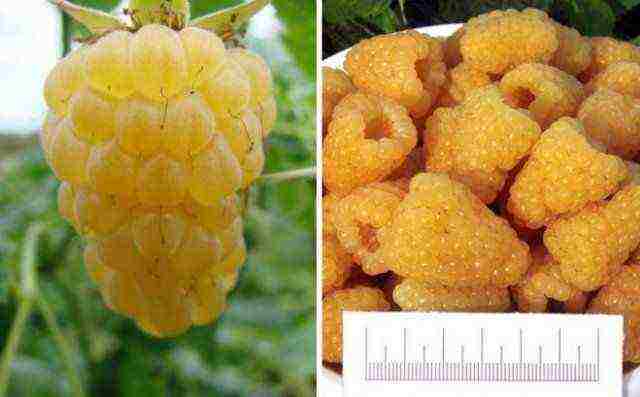
The berries have a dense flesh, the yield of the variety is good, it can reach 9 kg per bush. The berries have a pleasant taste, are well stored and transported.
12. Golden domes
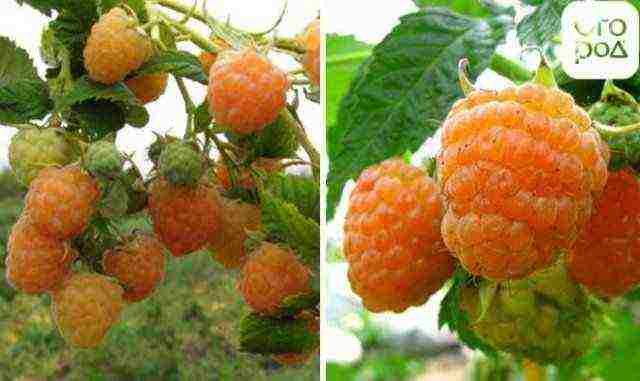
A large-fruited variety of raspberries, berries weighing more than 10 g, are colored orange. They have a truncated-conical shape. They give the first harvest in early August.
13. Orange miracle
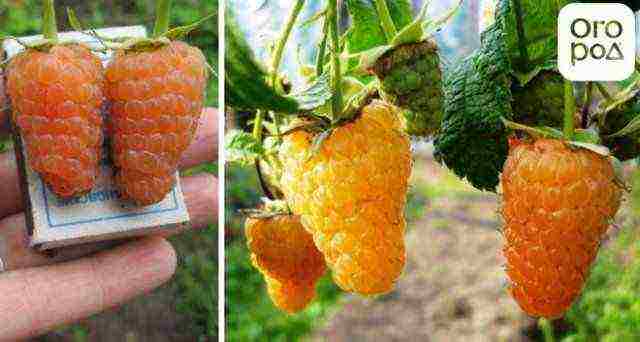
The berries are large, weighing from 4.5 to 9 g. They have a pleasant sweet taste.
14. Cleopatra
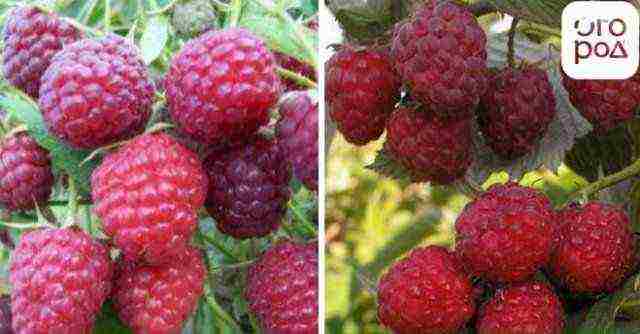
A variety of medium ripening. Vigorous, has dark green wrinkled leaves, sweet raspberry-colored berries, which have a conical shape and a weight of about 5 g. The average yield per bush for both varieties is about 4 kg.
Large-fruited raspberries boast not only large berries, but also high yields. The main disadvantage of these varieties is low winter hardiness and susceptibility to diseases and viruses. But why not give one of these proven strains a shot? It may well be that the results will please you.
25 Sep 2018 16:18 | No. 100 0 57 0
The berry season was successful this year. Warm spring helped raspberries to successfully enter fruiting. In winter, I did not cover my berry fields, even in Central Ukraine they overwintered well. Until June 15, I carried out top dressing with nitrogen-containing preparations, then with phosphorus, and at the end of fruiting - with potash. Fertilized exclusively on the leaf.
Patricia gives 8 kg per bush
This summer, all varieties have shown their best side, but still I want to mark the very best. Among the summer (disposable) varieties of raspberries, the beauty really pleased Patricia.
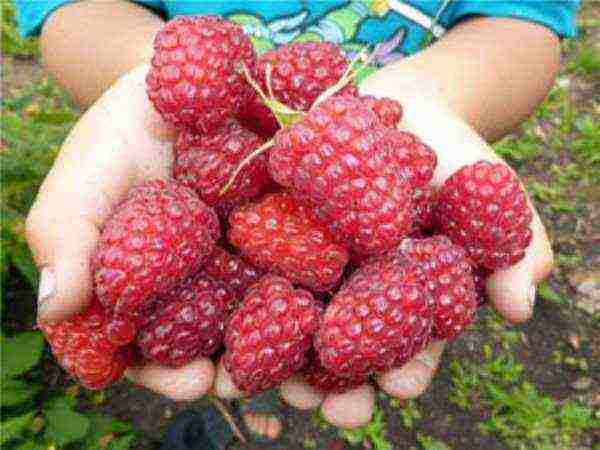 Its shoots are absolutely thornless, the average height is 150-180 cm. The average ripening period, with beautiful, very large (6-12 g) berries of light red color, attractive appearance, regular shape. One drawback — fruit transportability is weak. But the yield is very high — from 4 to 8 kg per bush. Dessert-type berries with a pleasant raspberry aroma.
Its shoots are absolutely thornless, the average height is 150-180 cm. The average ripening period, with beautiful, very large (6-12 g) berries of light red color, attractive appearance, regular shape. One drawback — fruit transportability is weak. But the yield is very high — from 4 to 8 kg per bush. Dessert-type berries with a pleasant raspberry aroma.
Patricia has confidently won the sympathy of gardeners thanks to its surprisingly large, long berries, which can reach 5 cm.
Hit the top three and Glen Fine... This variety is mid-early summer and has no thorns either.
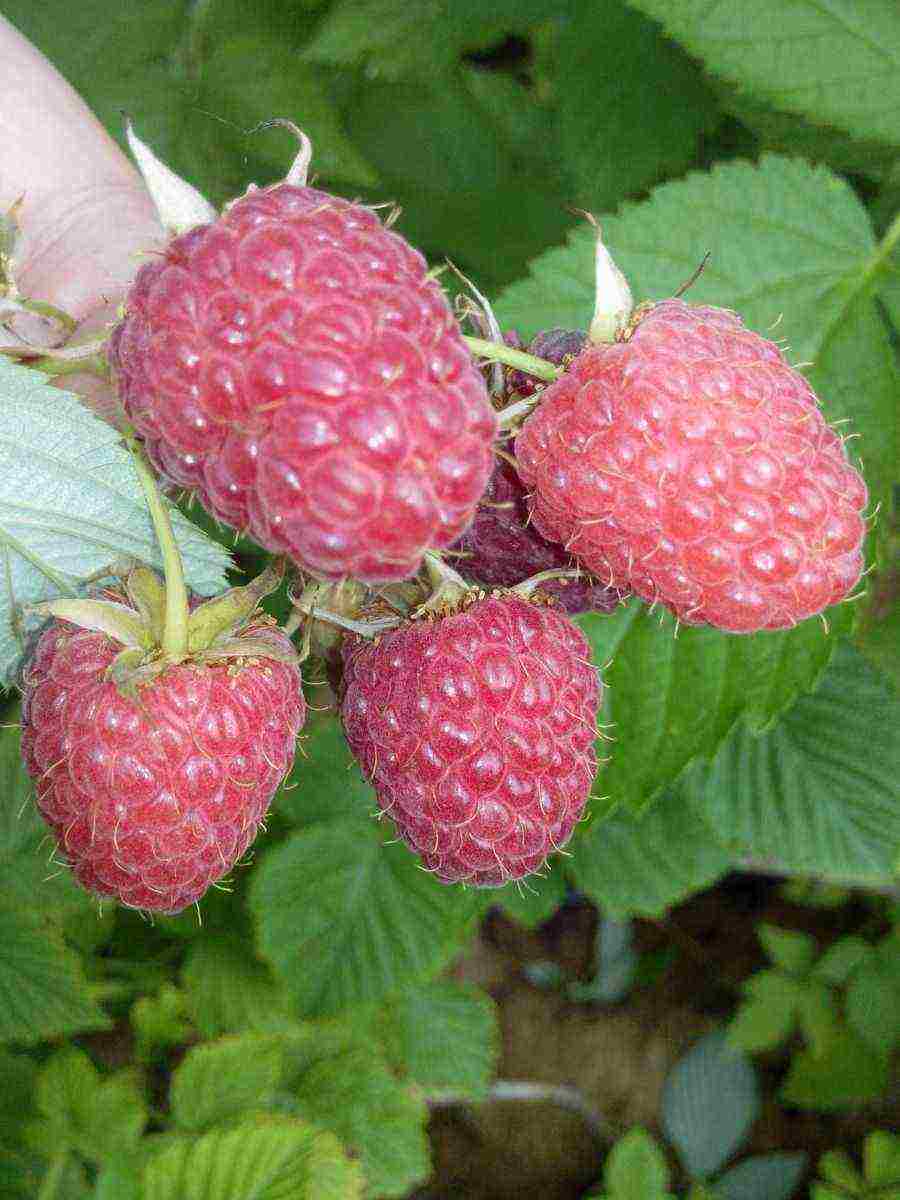 Fruiting begins in mid-July. You can collect 4-6 kg from one bush. The stems are powerful, absolutely without thorns, 150-180 cm high. Berries have an average weight of 5-7 g, some can reach 10 g.
Fruiting begins in mid-July. You can collect 4-6 kg from one bush. The stems are powerful, absolutely without thorns, 150-180 cm high. Berries have an average weight of 5-7 g, some can reach 10 g.
Glen Fine can be grown without trellis. Possesses sufficient winter hardiness.
Pleased with the harvest Tarusaknown as the crimson tree. The height of the raspberry is 1-1.5 m. The berries are elongated, large, weighing up to 10 g, dense and withstand transportation well. The berry taste is sweet, with a pleasant raspberry aroma, juicy melting pulp and few small seeds, well suited for fresh consumption and for all types of home processing (preserves, jams, candy, drying). The Tarusa variety is called a raspberry tree for its powerfully developed shoots. Tarusa — one of the most productive. Productivity is high, and with good care and manure application, the yield doubles. Resistant to low winter temperatures.
Patricia and Tarusa give the harvest together, fruiting lasts no more than 2 weeks.
Glen Magna for the southern regions
I cannot but recall the best varieties of summer "prickly" raspberries. After all, to a good grade — thorns are not a hindrance. These include Lyashka, Cascade Delight and Glen Magna.
Lyashka — mid-early grade. Fruiting begins on June 5-10. Stems are rigid, bow-shaped at the top of the shoots. The spines are numerous, but small, not very aggressive. Two-year-old shoots produce a large number of fruiting shoots of medium length. The fruits are very large, elongated, red, slightly pubescent, tasty. The average weight of berries is 5-8 g.
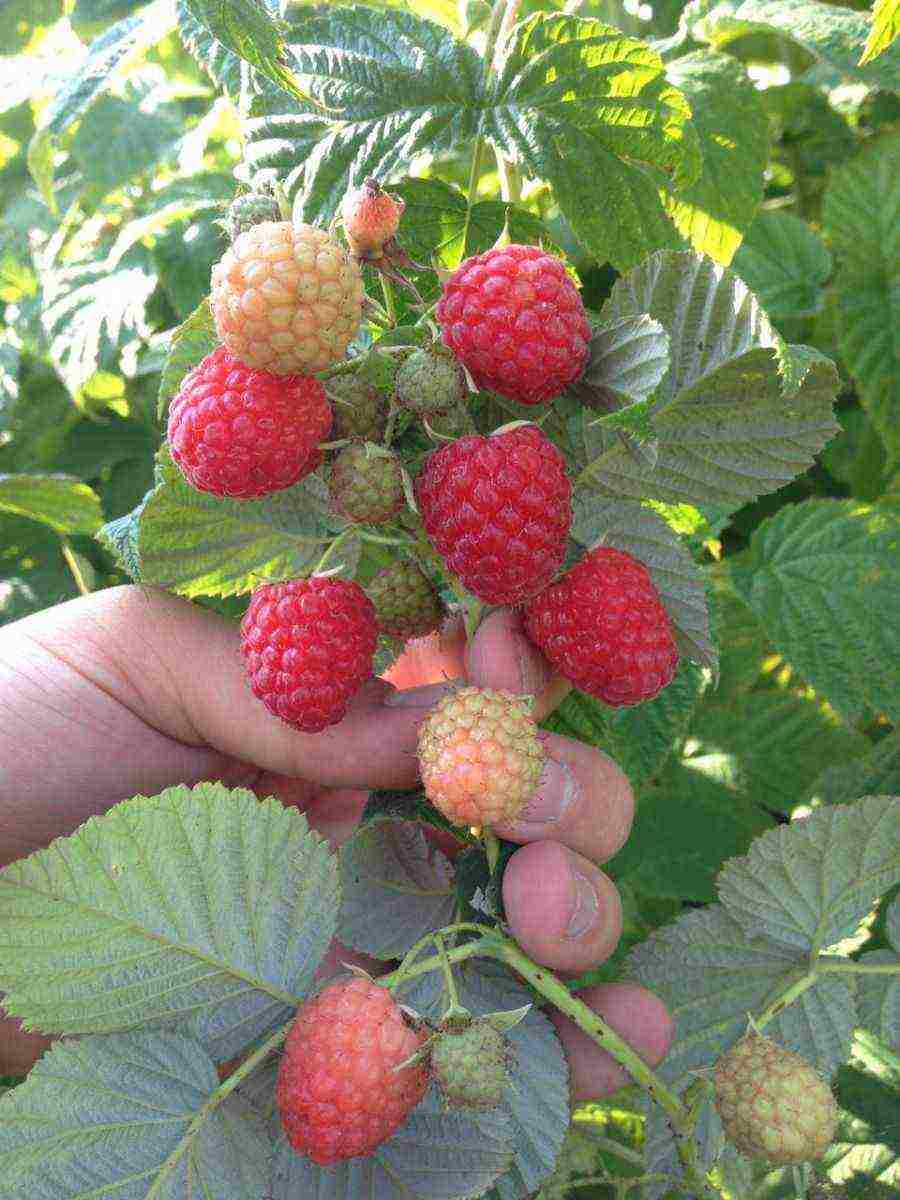 Cascade Delight is a novelty of American breeding. A mid-late variety of summer fruiting type, has a powerful root system, which allows it to easily endure both rainy and dry summers. Therefore, for the southern regions, where in recent years there has been an abnormal heat without rain, this variety is suitable. The average weight of berries is 5-7 g.
Cascade Delight is a novelty of American breeding. A mid-late variety of summer fruiting type, has a powerful root system, which allows it to easily endure both rainy and dry summers. Therefore, for the southern regions, where in recent years there has been an abnormal heat without rain, this variety is suitable. The average weight of berries is 5-7 g.
The raspberry variety Glen Magna is also not afraid of drought or rain. The berries are cone-shaped, fleshy. Well suited for the market. The average weight of fruits is 5-7 g. Fruiting is extended from June 20 to July 10-15, that is, you can feast on delicious berries for three whole weeks.
Of the remontant varieties, I want to note Brusvyanu, Cap of Monomakh, Penguin, Zyugan and Eric.
WHEN IT IS NOT WORTH TO CUT
Remontant varieties bear fruit from the end of July. — early August to September. It all depends on the weather. So, for example, Erica pleases with the first berries on August 10th. It belongs to the later varieties. Fruiting until mid-September, and sometimes until the end of the month. By the way, Zyugana also bears fruit with might and main. Only have time to pick berries.
In care, summer and remontant raspberries are practically the same, although there are some peculiarities. Fertilize all raspberries without exception with nitrogen, phosphorus and potassium on the leaf. I bring in organic matter when planting. Also, do not forget about pest and disease control. By the way, the remontant raspberries on my site practically do not get sick and are not damaged by any beetles. It's just that its developmental phases do not coincide with the developmental phases of pests. Whereas summer raspberries get full, but if spraying with fungicides and insecticides is carried out on time, nothing and no one can affect the harvest.
There are also differences in pruning. Summer raspberries are pruned immediately after fruiting. Keep in mind that she will give birth on 2 year old wood. Be sure to feed with potassium-phosphorus fertilizers so that replacement sprouts develop well. Repaired raspberries should never be cut off immediately after fruiting. You need to wait until the sap flow stops, that is, all the nutrients from the shoots will go down to the roots. This usually happens at the end of October. — November.
Valentina RUDENKO, experienced gardener,Cherkasy.
Loading ...
